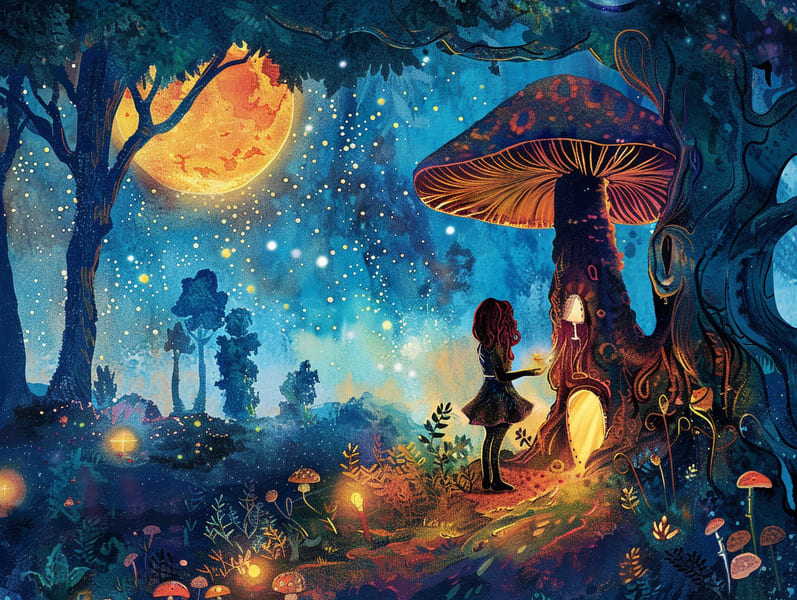
Fairy tales have ancient roots. These tales have been conveyed from one generation to the next well before they were ever documented. They emerged from a variety of civilizations, including European traditions. They were initially conveyed among mature audiences, often carrying themes and messages mirroring the societal norms and beliefs of the time.
Jacob and Wilhelm Grimm, Jacob and Wilhelm, were among the first to assemble many of these beloved narratives. Their collection, "Grimm's Children's Stories," included classics like "The Story of Cinderella," "Hansel and Gretel," and "Schneewittchen," which have since become classics in the world of children's fairy tales. Similarly, Hans Andersen's fanciful tales, such as "The Story of the Little Mermaid," and "The Story of the Ugly Duckling," have enchanted hearts worldwide, securing their place in the pantheon of timeless fairy tales.
Despite their ancient origins, these tales remain as important as ever, especially as bedtime stories for kids. These charming stories are now available in diverse formats, including beautifully illustrated books, enchanting animations, and digital storybooks.
Their persistent charm can be credited to several enchanting factors:
Crucial Morals: Ancient fairy tales often provide important moral lessons. Stories like "The Story of the Boy Who Cried Wolf" teach the merit of integrity, while "The Story of the Tortoise and the Hare" point out the merits of determination and humbleness. These tales offer young readers clear distinctions between good and bad, molding their moral compass in a soft yet meaningful way.
Sympathy and Perception: Old fairy tales frequently showcase beings facing challenges and struggles, inciting children to comprehend with their struggles and cheer for their triumphs. For instance, "Beauty and Her Beast" demonstrates the merit of seeing beyond the surface to recognize the real character of a person, advancing insight and awareness.
Cultural Understanding: Many traditional fairy tales are imbued with the cultural contexts from which they emerged. Discovering these tales can provide captivating looks into different heritages, fostering a sense of global awareness and understanding.
Fantasy and Imagination: The mythical elements in old fairy tales—mythical entities—ignite children’s dreams. These narratives move readers to supernatural realms, enhancing fantasy ideas and a sense of mystery that persists a lifetime.
Traditional fairy tales are not only bewitching but also instructive. They work as delightful tools in nurturing various mind and heart abilities in little ones. When classic fairy tales are told out loud, they strengthen verbal skills by introducing new linguistic elements and elaborate sentence structures. This practice also cultivates auditory perception and mindfulness, as children keep up with the story, keen to see what happens next.
Furthermore, deliberating the themes and characters of fairy tales can nurture thinking skills and thinking skills. Children are led to detect patterns, forecast, and know cause and effect. These talks also help the young articulate their thoughts and feelings, fostering their emotional intelligence.
In today’s technological age, the availability of digital fairy tales has made these tales more within reach than ever. Internet resources and digital apps share ample collections of ancient fairy tales that can be enjoyed or played anytime, anywhere. Fairy tales read aloud are particularly in demand, extending an charming way for young readers to be a part of these alluring stories. Read-aloud books and narrated videos transport characters and settings to life, often joined by spellbinding melodies and soundtracks that heighten the tale journey.
The unending appeal of old fairy tales lies in their ability to adjust to the present while sustaining their key morals. Contemporary takes of these fairy tales often spotlight more multicultural figures and modern settings, making them meaningful to today’s audience. However, the fundamental themes of valor, benevolence, and fair play remain unchanged, continuing to strike a chord with readers of all ages.
Fairy tales also offer a sense of contentment and familiarity. They bring a ordered narrative with a straightforward beginning, middle, and end, often wrapping up with the settlement of conflicts and the triumph of good over evil. This assuredness can be easing for the young, giving a sense of dependability in an fluid world.
Old fairy tales continue to delight and guide new generations, maintaining their charm and pertinence in modern society. As nighttime stories for kids, they feature a perfect blend of fantasy and learning, enriching moral values, empathy, and creativity. The abundance of digital awesome site fairy tales and the in demand status of fairy tales recited affirm that these classic fairy tales remain acquirable to new generations.
By maintaining and sharing these stories, we continue to cherish the rich tapestry of mythology and cultural heritage. Whether you are exploring a beautifully illustrated book, discovering a virtual library, or listening to an read-aloud book, the fascination of children's fairy tales is always within reach. These tales point out of the persistent nature of tales and its ability to draw us together across eras and regions.
Whether you are perusing a colorful picture book, discovering a electronic library, or listening via an narrated book, the majesty of children's fairy tales is always within reach.
These narratives show us of the unceasing power of tales and its ability to unite us across epochs and places, making a tie that delights and instructs alike.
Comments on “The Dawn of Short Fairy Tales and the Unfading Magic.”